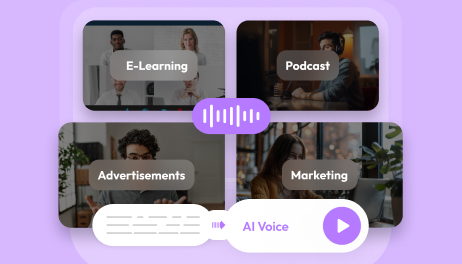
When it comes to making the world more accessible, AI voiceover is an important tool. As technology becomes more advanced and accessible, it will have a large role in helping people with disabilities enjoy everything from shopping to entertainment. Voiceover technology is a new way to help people with disabilities. It allows them to have the same access to information, entertainment, and services that others enjoy. Voiceover technology can improve their quality of life and make their lives more enjoyable because they can communicate more easily with others who don’t know sign language or other communication methods. In this article, we’ll explore what AI voiceover is and how it could be used in your business in order to increase accessibility for people with disabilities.
What is AI Voiceover?
AI voiceover is a technology that enables the creation of synthetic voices. These synthetic voices can be used to create voiceovers for apps, websites, videos and podcasts.
The technology works by recording an original audio segment using a human voice actor and then using software to generate new words from these recordings. It’s similar to what happens when you record yourself speaking into your phone camera and then play it backwards – except instead of playing it back as if no one were listening (which would sound like gibberish), you play back the same recording with all its natural characteristics intact while being filtered through advanced algorithms designed specifically for this purpose: they make sure there are no mistakes along the way so that when someone listens as if nothing had been done at all – they hear something intelligible!
AI voiceover: A brief overview
AI voiceover or automated speech synthesis (ASR) is a type of artificial intelligence that uses voice recognition technology to generate new text. The process involves taking spoken words and converting them into written text. This allows people with disabilities to communicate more effectively through digital devices such as smartphones and computers.
As you may know, there are many ways for machines to produce human-like speech: Google has developed its own system called DeepMind Voice 2; Microsoft has created their own software called Cortana; IBM’s Watson is also capable of generating natural sounding responses based on your questions or commands—but no matter how advanced these technologies become over time there will always be something missing from each one of them because they all rely heavily on pre-existing databases that contain specific information about certain topics such as sports teams or celebrities and triathlon training program who were born in a particular year (e.g., 2017).
In contrast, AI voiceover relies entirely on machine learning algorithms that analyze large amounts of data collected over time by people interacting with various platforms like Facebook Messenger Chatbot Developers Guide: Mastering Natural Language Processing For Chatbots On Facebook Messenger FirstPerson Voice Recognition Platforms And Services!
Potential benefits of AI voiceover
- AI voiceover can help people with disabilities.
- AI voiceover can help people who have trouble reading.
- AI voiceover can help people who have trouble hearing.
- AI voiceover can help people who have trouble seeing.
- AI voiceover can even be used as an accessibility feature for those with physical disabilities, such as dyslexia or blindness!

AI Voiceover for people with disabilities
It’s easy to forget that not everyone has the same eye for images that you do. People who are blind or have low vision often have trouble seeing images on the Internet, because of their disability, accessibility issues with the website, or a combination of both.
Images can be a great way to convey information, but they need to be accessible so that everyone can see them. This is why we developed our AI voiceover tool—a new way of creating audio content that allows users with disabilities such as blindness and low vision (including colour blindness) to use it without having an interpreter present at all times.
Voiceover technology is a tool that can help people with disabilities to access information and create content. It allows them to become more independent, as they can interact with computers, tablets and smartphones without relying on someone else.
Voiceover works by allowing users to type text into their device using the screen reader software provided by their manufacturer or service provider. This will then be read out loud so that it can be understood by the user who has no sight or hearing impairments but requires some level of assistance with tasks such as sending emails or making purchases online. The most common use case for AI voiceover is when you need to describe something that’s difficult or impossible to understand without it (like a photo). AI will also help people who are blind or don’t have good eyesight interpret images when they visit your site.
Conclusion
As AI voiceover technology becomes more prevalent, it helps provide a better and more accessible experience for everyone to use. Voiceover technology provides people with disabilities access to information and the ability to create content. It also opens up new possibilities for people who have limited mobility, including older adults who may struggle with typing or other computer input devices. With AI voiceover, voice is no longer the limiting factor for people with disabilities—instead it becomes an opportunity to empower them through technology!
This article has been a brief overview of AI voiceover, and how we can use ai technology to empower disabled people. We hope you have found this useful in understanding more about how AI can help everyone in our society with disabilities. It’s not just about people with disabilities. It’s about making sure everyone can use your website, product or service. It’s about ensuring everyone understands what you are trying to say on your site or in your marketing campaigns.







